This is the order of battle of the Imperial German Navy (Kaiserliche Marine) on the outbreak of World War I in August 1914.
Commanders and locations of the Imperial German Navy

The overall commander of the Imperial German Navy was Kaiser Wilhelm II. All authority over the navy was vested in the Kaiser, and he was ultimately responsible for all decisions regarding the navy. Under the Kaiser were a number of organisational bodies responsible for various aspects of the navy's administration and operation, each of which was directly responsible to the Kaiser:
- The Naval Cabinet was a body of the Imperial Household, with responsibility over promotions and appointments, and the drafting and issuing of the Kaiser's orders.
- Chief of the Naval Cabinet - Admiral Georg von Müller
- The Imperial Naval Administration was the government department with responsibility for the Navy, which was answerable to the Imperial Chancellor, and was headed by the State Secretary.
- State Secretary - Grand Admiral Alfred von Tirpitz
- Deputy State Secretary - Vice-Admiral Eduard von Capelle
- State Secretary - Grand Admiral Alfred von Tirpitz
The departmental heads within the Imperial Naval Administration were:
| Nautical Department | Vice-Admiral Max von Grapow |
| Armaments Department | Vice-Admiral Gerhart Gerdes |
| Shipyard Department | Vice-Admiral Karl Dick |
| Naval Construction Department | Vice-Admiral Friedrich Schrader |
| German Department | Rear-Admiral Friedrich Bodicker |
| States Department | Vice-Admiral Harald Dähnhardt |
- The Admiralty Staff was formed in 1899 to replace the Naval High Command, and operated as an organisation intended to gather intelligence and prepare operational plans for presentation to and approval of the Kaiser.
- Chief of the Imperial Admiralty Staff - Vice-Admiral Hugo von Pohl
- Deputy Chief of Staff - Rear-Admiral Paul Behncke
- Head of the Central Bureau - Rear-Admiral Albert Hopman
- Chief of the Imperial Admiralty Staff - Vice-Admiral Hugo von Pohl
- The Inspector-General of the Navy was a post held intermittently, intended to undertake inspection of the navy itself to ensure it was operating at maximum efficiency. The Inspector-General's office was divided into a number of individual inspectorates related to different areas of the Navy's operations.
- Inspector-General of the Navy - Grand Admiral Prince Heinrich of Prussia
- 2nd Inspector-General - Rear Admiral Karl Zimmerman
- Inspector-General of the Navy - Grand Admiral Prince Heinrich of Prussia
-
 Admiral Müller,
Admiral Müller,
Chief of the Naval Cabinet -
 Grand Admiral Tirpitz,
Grand Admiral Tirpitz,
State Secretary of the Imperial Navy Office -
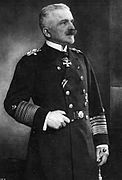 Vice-Admiral Pohl,
Vice-Admiral Pohl,
Chief of the Imperial Admiralty Staff -
 Grand Admiral Prince Heinrich of Prussia,
Grand Admiral Prince Heinrich of Prussia,
Inspector-General of the Navy
Training schools
 Mürwik Naval School
Mürwik Naval School The officers' training ship König Wilhelm
The officers' training ship König Wilhelm
The navy had a number of establishments to train its personnel, both generally and in specific technical areas. In addition, a number of ships were on the strength of training establishments to provide practical experience.
- Mürwik Naval School - primary training establishment for officers
- Boiler and Engine Room Training Schools
- SMS Kronprinz (Boiler room training ship)
- SMS Fürst Bismarck (Engine room training ship)
- Gunnery training school
- Torpedo training school
German naval bases
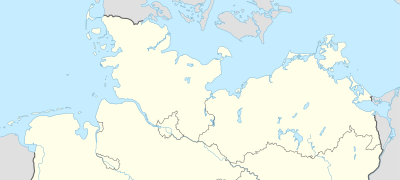

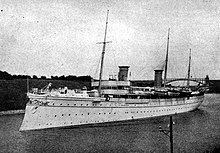
Germany had two major naval bases covering its main areas of interest:
- Kiel - headquarters of the Baltic Naval Station, which was also responsible for the base at Danzig in East Prussia.
- Commander, Baltic Naval Station - Vice-Admiral Gustav Bachmann
- Chief of Staff - Rear-Admiral Georg Hebbinghaus
- Commander, Kiel Naval Base - Vice Admiral Konrad Henkel-Gebhardi
- Commander, Kiel Fortress - Vice Admiral Reinhard Koch
- Commander, Danzig Naval Base - Rear Admiral Franz von Holleben
- In addition to hosting the fleet units stationed in the Baltic Sea, a number of other units were under the direct command of the Baltic Naval Station commander:
- 1st Seaman Division (Kiel)
- 1st Marine Artillery Division (Friedrichsort)
- 1st Torpedo Division (Kiel)
- 1st Battalion of Marines
- As well as the warships of the fleet, a further unit of the Imperial Navy stationed at Kiel was the Imperial Yacht, which was the personal vessel of the Kaiser, used both for his annual cruise to Norway as well as transporting him on overseas visits, but was also available for use as an aviso, or despatch boat.
- Commander, Baltic Naval Station - Vice-Admiral Gustav Bachmann
- Wilhelmshaven - headquarters of the North Sea Naval Station, which also served as the host base of the High Seas Fleet.
- Commander, North Sea Naval Station - Vice-Admiral Günther von Krosigk
- Commander, Wilhelmshaven Naval Base - Rear-Admiral Hugo Kraft
- Commander, Wilhelmshaven Fortress - Rear-Admiral Friedrich Schultz
- Commander, Wesermunde Fortress - Vice-Admiral Johannes Schröder
- Commander, Helgoland Fortress - Vice-Admiral Leo Jacobson
- As well as hosting the High Seas Fleet, other units were also under the direct command of the North Sea Station commander:
- 2nd Seaman Division
- 2nd Marine Artillery Division
- 3rd Marine Artillery Division
- 4th Marine Artillery Division
- 2nd Torpedo Division
- 2nd Battalion of Marines
- Commander, North Sea Naval Station - Vice-Admiral Günther von Krosigk
In addition to its two major bases in Germany, the Imperial German Navy had a number of units stationed overseas.
Barrack ships
As well as barracks ashore, the navy maintained a number of old and withdrawn ships for use as accommodation for its personnel while in harbour.
- ex-Nixe
- ex-Moltke
- ex-Sophie
- ex-Bismarck
- ex-Stein
- ex-Leipzig
- ex-Meteor
- ex-Schwalbe
- ex-Gefion
- ex-Kaiser
High Seas Fleet


The High Seas Fleet (Hochseeflotte) was the primary formation of the Imperial German Navy, with its main element being the three operational battle squadrons to which the navy's battleships were assigned. The majority of units of the High Seas Fleet were stationed at Wilhelmshaven for operations in the North Sea. A small force was stationed at Kiel for use in the Baltic, which could be quickly reinforced by North Sea-based units via the Kaiser Wilhelm Canal. The High Seas Fleet was under the command of Admiral Friedrich von Ingenohl.
Battle squadrons
- Fleet Flagship (Admiral Friedrich von Ingenohl)
- 1st Battle Squadron (Vice-Admiral Wilhelm von Lans)
- 1st Division
- SMS Ostfriesland (Flagship)
- SMS Helgoland
- SMS Oldenburg
- SMS Thüringen
- 2nd Division (Rear-Admiral Friedrich Gädecke)
- SMS Posen (Flagship)
- SMS Nassau
- SMS Rheinland
- SMS Westfalen
- 1st Division
- 2nd Battle Squadron (Vice-Admiral Reinhard Scheer)
- 3rd Division
- SMS Preussen (Flagship)
- SMS Deutschland
- SMS Hessen
- SMS Lothringen
- 4th Division (Kommodore Franz Mauve)
- 3rd Division
- 3rd Battle Squadron (Rear-Admiral Felix Funke)
- 5th Division
- The 5th Division, under Rear-Admiral Carl Schaumann, was formed of battleships of the König class. The first to be commissioned was Grosser Kurfürst on 30 July, which was undergoing sea trials on the outbreak of war. The remaining three ships were commissioned through the remainder of 1914.
- 6th Division
- 5th Division
- Tenders
Scouting groups
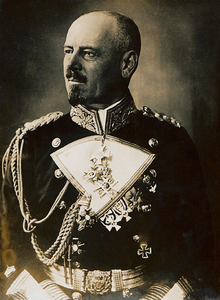
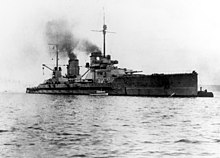
- 1st Scouting Group (Rear-Admiral Franz von Hipper)
- SMS Seydlitz (Flagship)
- SMS Blücher
- SMS Moltke
- SMS Von der Tann
- 2nd Scouting Group (Rear-Admiral Leberecht Maass)
- 3rd Scouting Group (No flag officer)
- SMS München (Flagship)
- SMS Danzig
- SMS Frauenlob
- SMS Hela
- SMS Stuttgart
- 4th Scouting Group (Rear-Admiral Hubert von Rebeur-Paschwitz)
- SMS Roon (Flagship)
- SMS Prinz Adalbert
- SMS Prinz Heinrich
- SMS Yorck
- 5th Scouting Group (Rear-Admiral Gisbert Jasper)
- SMS Hansa (Flagship)
- SMS Hertha
- SMS Victoria Louise
- SMS Vineta
Torpedo boats
- 1st Torpedo Boat Flotilla
- 2nd Torpedo-Boat Flotilla
- 3rd Torpedo-Boat Flotilla
- 4th Torpedo-Boat Flotilla
- 5th Torpedo-Boat Flotilla
- 6th Torpedo-Boat Flotilla
- 7th Torpedo-Boat Flotilla
- 8th Torpedo-Boat Flotilla
U-boats and Mine warfare
- 1st U-boat Flotilla
- 2nd U-boat Flotilla
- Tenders
- 1st Minesweeping Division
- 2nd Minesweeping Division
- 3rd Minesweeping Division
- Minelayers
Coastal defence

A number of small units were formed whose primary purpose was coastal and harbour defence of the various naval bases in and around Wilhelmshaven. These usually consisted of one or more light cruisers, commanding a number of torpedo-boat destroyers and other vessels. To provide heavy support for coastal defence, one of the reserve squadrons of the High Seas Fleet, consisting of eight obsolete coastal defence ships that were of no use as part of the main battle fleet, was assigned to the North Sea coast.
- 6th Battle Squadron (Rear-Admiral Richard Eckermann)
- 11th Division
- SMS Hildebrand (Flagship)
- SMS Frithjof
- SMS Hagen
- SMS Heimdall
- 12th Division (Rear-Admiral Ehler Behring)
- SMS Agir (Flagship)
- SMS Beowulf
- SMS Odin
- SMS Siegfried
- 11th Division
- Coast Defence Division Ems (Emden)
- Outpost Half-Flotilla Helgoland (Heligoland)
- Coast Defence Division Jade/Weser (Wilhelmshaven)
- Coast Defence Division Elbe (Cuxhaven)
Baltic Fleet
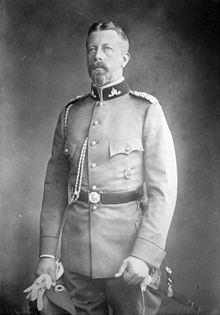

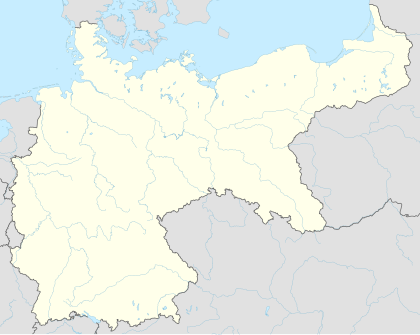
Although part of the High Seas Fleet, the force stationed permanently at Kiel for operations in the Baltic operated with a degree of independence. Grand Admiral Prince Heinrich of Prussia, the brother of Kaiser Wilhelm II, was the commander-in-chief of the Baltic Fleet, with Rear-Admiral Robert Mischke in operational command of units at sea.
Coast Defence Group Baltic
- Fleet Flagship (Grand Admiral Prince Heinrich of Prussia)
- 6th Scouting Group (Rear-Admiral Robert Mischke)
- Other vessels
- Torpedo-Boat Flotilla
- U-boat Flotilla
- Minelayers
Battle squadrons
- 4th Battle Squadron (Vice-Admiral Ehrhard Schmidt)
- 7th Division
- SMS Wittelsbach (Flagship)
- SMS Mecklenburg
- SMS Schwaben
- SMS Wettin
- 8th Division (Rear-Admiral Hermann Alberts)
- SMS Braunschweig (Flagship)
- SMS Elsass
- SMS Zähringen
- 7th Division
- 5th Battle Squadron (Vice-Admiral Max von Grapow)
- 9th Division
- 10th Division (Kommodore Alfred Begas)
Outpost Half-Flotilla Kiel / Elder
- Torpedo-Boats
- Other ships
Naval Aviation
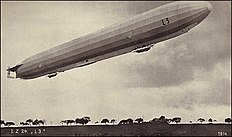 Zeppelin L 3 - the Imperial Navy's sole operational airship at the start of the war
Zeppelin L 3 - the Imperial Navy's sole operational airship at the start of the war Friedrichshafen FF.29 - one of the first operational aircraft of the Naval Flying Detachment
Friedrichshafen FF.29 - one of the first operational aircraft of the Naval Flying Detachment
The Imperial German Navy had a small aviation capability, which was originally formed in 1913 when the Kaiser decreed the foundation of the Naval Aviation Forces (Marinefliegerkräfte). Within the newly formed aviation section were two separate commands - the Naval Airship Detachment, based at Nordholz, near Cuxhaven, and the Naval Flying Detachment, which was split between Kiel, Heligoland and Putzig.
- Naval Airship Detachment
- Naval Flying Detachment
- 1st Naval Flying Detachment
- Kiel Detachment
- Heligoland Detachment
- Putzig Detachment
- 1st Naval Flying Detachment
Overseas units
 Vice-Admiral Spee
Vice-Admiral Spee Rear-Admiral Souchon
Rear-Admiral Souchon
In addition to the main body of the Imperial German Navy stationed in home waters, Germany also maintained a number of overseas deployments of ships. The majority of these were usually of one or two cruisers operating independently, with the primary formation of German warships outside German waters being the East Asia Squadron, under the command of Vice-Admiral Maximilian von Spee, which was stationed at Tsingtao. The navy also provided a significant proportion of the garrison at Tsingtao, with approximately 1,200 of the 3,000 strong garrison coming from one of the marine battalions. The other major formation was the Mediterranean Division, commanded by Rear-Admiral Wilhelm Souchon.
- East Asia Squadron (Vice-Admiral Maximilian von Spee)
- Mediterranean Division (Rear-Admiral Wilhelm Souchon)
- SMS Goeben (Flagship)
- SMS Breslau
- SMS Loreley
- East and West America station
- East African station
- West African station
- South Sea station
- Tsingtao Garrison
-
 Scharnhorst, flagship of the East Asia Squadron
Scharnhorst, flagship of the East Asia Squadron
-
 Goeben, flagship of the Mediterranean Division
Goeben, flagship of the Mediterranean Division
-
 German marines in Tsingtao, 1914
German marines in Tsingtao, 1914
Notes
- The different inspectorates were Coast Artillery & Mines; Ship Artillery; Naval Construction; Torpedoes; Depots
- ^ Prince Heinrich served as both the Inspector-General of the Navy and Commander-in-Chief of the Baltic Fleet.
- Hohenzollern was scheduled for replacement in 1914, and was planned to be withdrawn from service at the end of the Kaiser's 1914 Norwegian cruise. A new yacht, also named Hohenzollern, was launched in September 1914, but never completed.
- During a full mobilisation of the battle fleet, Friedrich der Grosse was attached to the 3rd Squadron alongside her Kaiser-class sister ships.
- The remaining three ships of the division were König (flagship, commissioned 10 August 1914); Markgraf (commissioned 1 October 1914); and Kronprinz (commissioned 8 November 1914).
- Derfflinger was commissioned on 1 September and was assigned to the I Scouting Group in late October
- Although remaining part of the 1st Scouting Group, Blücher was deployed to the Baltic on operations for the first three months of the war
- Rear-Admiral Maass also served as the commander of the fleet's Torpedo-Boats
- Graudenz was commissioned on 10 August and assigned to the II Scouting Group
- ^ Sunk during the Battle of Heligoland, 28 August 1914
- ^ Rostock was attached to the battle fleet and Kolberg to the scouting groups as the leaders of the fleet's torpedo boats during fleet actions
- Commodore Karl von Restorff was appointed as commanding officer on 1 January 1915
- ^ The 3rd and 4th Scouting Groups swapped identities on 25 August 1914
- Prinz Adalbert was transferred to the Baltic Fleet in late August 1914
- The ships of the 5th Scouting Group were assigned to the Baltic Station, but remained under the command of the High Seas Fleet until September 1914
- S143 was sunk on 3 August 1914, and replaced by S138
- Hamburg was attached to the 4th Scouting Group as the leader of the fleet's u-boats during fleet actions
- Königin Luise was requisitioned from the Hamburg America Line on 3 August 1914 for service as an auxiliary minelayer. Two days later, during a minelaying mission to the Thames Estuary, the ship was sunk by British destroyers.
- ^ The modern torpedo-boats V25, V26 and V186 were transferred to the North Sea station forming part of the new 9th Flotilla in October 1914. They were replaced by G132-G136.
- In late August 1914, the 6th Scouting Group was split into two, with Augsburg, Gazelle, Lubeck and Magdeburg being utilised as the "Detached Division" for offensive operations in the Baltic Sea.
- The light cruiser Bremen was undergoing a major refit on the outbreak of war. Upon completion of the work in May 1915, Bremen was assigned to the Baltic Fleet.
- Although Freya was mobilised for war service, she was employed primarily as a training ship
- Wrecked following grounding at Osmussaar, 26 August 1914
- Panther had completed an overhaul at Danzig and was due to be deployed to the Caribbean on the outbreak of war.
- ^ The 4th and 5th Squadrons were detached from the High Seas Fleet to provide heavy support to the Baltic Fleet in August 1914.
- The airship detachment had a single operational airship on the outbreak of war. By the end of 1914, another five had been commissioned
- Cormoran was undergoing repairs on the outbreak of war. As a result of the work not being finished, the ship was stripped of weapons to be used to reinforce the defences of Tsingtao, and decommissioned, with her name and crew being transferred to a captured Russian merchant ship that was converted into an armed merchant cruiser.
- Prinz Eitel Friedrich was a liner operated by Norddeutscher Lloyd on its routes in the Far East. On the eve of war, she was ordered from Shanghai to Tsingtao for conversion into an armed merchant cruiser, and was commissioned into the Imperial Navy on 5 August 1914.
- Goeben had been scheduled to be replaced by Moltke in June 1914
- ^ Sold to the Ottoman Navy on 11 August 1914
References
- ^ Watson, Graham. "Introduction to Die Kaiserliche Marine 1914-1918". Organisation of the Imperial German Navy 1914-1918. naval-history.net. Retrieved 24 February 2022.
- Herwig p.22
- ^ Watson, Graham. "Flag Officers of the Imperial German Navy 1914-1918". Organisation of the Imperial German Navy 1914-1918. naval-history.net. Retrieved 26 February 2022.
- ^ Alton, Dave (2 September 2002). "Imperial German Navy Deployment, 1914". The WWI Document Archive. Retrieved 26 February 2022.
- Tarrant, p. 286
- Neumann, Arndt (14 September 2014). "100 Years of German Naval Aviation: A Continuous Change from the Beginning". Joint Air Power Competence Center. Archived from the original on 28 March 2022. Retrieved 26 February 2022.
- Bassett, p. 55
- "The Great War in the South Atlantic". The Critic. 8 December 2021. Retrieved 26 February 2022.
- "Aufstellung des III. Seebataillons". Gesichte der Marine-Infanterie (1675-1919) (in German). Retrieved 26 February 2022.
- Bassett, p. 40
- Staff, p. 15.
- Bassett, Ronald (1981). Battle-Cruisers: A History 1908-1948. London: Macmillan. ISBN 0-333-28164-0.
- Herwig, Holger H. (1980). 'Luxury Fleet', The Imperial German Navy 1888-1918. London: The Ashfield Press. ISBN 0-948660-03-1.
- Staff, Gary (2006). German Battlecruisers: 1914–1918. Oxford: Osprey Books. ISBN 978-1-84603-009-3.
- Tarrant, V. E. (1995). Jutland: The German Perspective. London: Cassell Military Paperbacks. ISBN 0-304-35848-7.